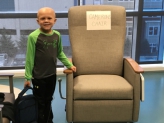In-vivo characterization of MYCN-driven immunosuppression

While immunotherapy has been highly successful in pediatric leukemia, results with solid tumors have been disappointing. As an example, high-risk neuroblastoma (NB) is adept at evading the immune system. and frequently presents with extensive incurable wide spread disease. Clinical observations indicated the potential for strong interactions between NB tumor cells and host immune cells and sparked early enthusiasm for immunotherapy.
However, immunotherapy has thus far met with mixed results in NB. An FDA-approved monoclonal antibody (dinutuximab) has improved survival while immune checkpoint inhibitor therapy has shown limited success A detailed understanding of the interactions between neuroblastoma tumor cells and immune cells is critical to understand how neuroblastoma achieves successfully evades the immune system, to enable effective immunotherapy strategies. Most studies of neuroblastoma tumors grow human tumors on plastic, without immune cells, or in immunocompromised mice, which have genetically defective immunity required to grow a human tumor in a mouse.
While my lab has pioneered the generation of mouse models for neuroblastoma (which grow in an immune intact animal) our existing models are inadequate to meet the needs of preclinical immuno-oncology testing. The most widely used TH-MYCN model (generated in my lab 20 years ago) is penetrant in a mouse strain for which there are no immunological genetic tools available, which compromises our ability to study how these tumors evade immunity. Here, we describe a mouse model for high-risk neuroblastoma, well suited to dissect how this tumor so effectively evades the immune system.
Project Goals:
We have established a new, immune intact murine model of high-risk neuroblastoma, that closely reflects human tumors with regard to the types of immune cells that grow in concert with the tumor, and that grow through evading the immune system. We propose to use this model to characterize tumor and immune cells, and identify molecules secreted by both tumor cells and immune cells, that enable these two cell types to talk to each other, leading to immune evasion. For some of these secreted molecules, drugs may be available. In this case, we will test these agents to see if they block tumor growth in mice.
In addition, we will manipulate our model genetically, to improve immunity, to determine whether we can make awaken the immune cells to reject the tumor. We will monitor tumor growth in mice deficient for many different and specific cell types that comprise the immune system. In each case, we can profile cell types and relative abundance by taking a snapshot through a technology called mass cytometry. Successful completion of these studies identifies immune cell populations that modulate anti-tumor immunity.
By understanding the key cellular villains in this process, we are then poised to develop approaches to block cells that promote immune evasion, to reverse this process. By understanding the basis for immune evasion in a genetically manipulable model for this disease, we improve our ability to develop therapeutic approaches to help children with high-risk neuroblastoma.
Project Update 2024:
We have established a new, immune intact murine model of high-risk neuroblastoma, that models human tumors with regard to the types of immune cells that grow with the tumor by invading the immune system. We have demonstrated that like high-risk neuroblastoma in children, tumors in this model have few immune cells. Macrophages represent the predominant immune cell. We hypothesize that macrophages in these tumors help to orchestrate the tumor's ability to fight off tumor blocking immune cells, called T-cells. We saw no effect in response to treating tumors with checkpoint inhibitor drugs directed against a protein called PD-1, that increase T-cell activity and patient outcomes in melanoma. In contrast, we saw improved survival and improved T-cell infiltration in response to related treatment with PD-L1. While PD-1 and PD-L1 are thought to act directly on the tumor’s interaction with T-cells, we see instead that neither PD-1 nor PD-L1 are expressed on tumors. Instead, PD-L1 is expressed on macrophages, a finding we validated in human neuroblastoma. We hypothesized that PD-L1 blockade on macrophages will cooperate with other immunological therapies, and demonstrated this to be true.

